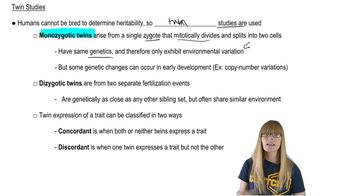Identify two general ways chemical mutagens can alter DNA. Give examples of these two mechanisms.
Table of contents
- 1. Introduction to Genetics51m
- 2. Mendel's Laws of Inheritance3h 37m
- 3. Extensions to Mendelian Inheritance2h 41m
- 4. Genetic Mapping and Linkage2h 28m
- 5. Genetics of Bacteria and Viruses1h 21m
- 6. Chromosomal Variation1h 48m
- 7. DNA and Chromosome Structure56m
- 8. DNA Replication1h 10m
- 9. Mitosis and Meiosis1h 34m
- 10. Transcription1h 0m
- 11. Translation58m
- 12. Gene Regulation in Prokaryotes1h 19m
- 13. Gene Regulation in Eukaryotes44m
- 14. Genetic Control of Development44m
- 15. Genomes and Genomics1h 50m
- 16. Transposable Elements47m
- 17. Mutation, Repair, and Recombination1h 6m
- 18. Molecular Genetic Tools19m
- 19. Cancer Genetics29m
- 20. Quantitative Genetics1h 26m
- 21. Population Genetics50m
- 22. Evolutionary Genetics29m
17. Mutation, Repair, and Recombination
Induced Mutations
Problem C.5b
Textbook Question
In March 2011 an earthquake measuring approximately 9.0 on the Richter scale struck Fukushima, Japan. Several nuclear reactors at the Fukushima Daichii Nuclear Power Plant were damaged, and nuclear core meltdown occurred. A massive release of radiation accompanied damage to the plant, and 5 years later the incidence of thyroid cancer in children exposed to the radiation was determined to be well over 100 times more frequent than expected without radiation exposure. DNA damage and mutations resulting from radiation exposure are suspected of causing this increased cancer rate. Do you think it is possible that significant increases in the incidence of other types of cancer will occur in the future among people who were exposed to the Fukushima radiation? Why?
 Verified step by step guidance
Verified step by step guidance1
Understand the biological effects of radiation: Radiation exposure can cause DNA damage, including single-strand breaks, double-strand breaks, and base modifications. These types of damage can lead to mutations if not properly repaired by cellular mechanisms.
Recognize the link between DNA mutations and cancer: Mutations in key genes, such as tumor suppressor genes or oncogenes, can disrupt normal cell cycle regulation, leading to uncontrolled cell growth and cancer development.
Consider latency periods for cancer: Different types of cancer have varying latency periods, which is the time between exposure to a carcinogen (like radiation) and the appearance of cancer. Some cancers, such as leukemia, may appear within a few years, while others, like solid tumors, may take decades to develop.
Evaluate the long-term exposure risks: People exposed to radiation at Fukushima may have an increased risk of developing other types of cancer in the future, depending on factors such as the dose of radiation received, the duration of exposure, and individual genetic susceptibility.
Conclude based on scientific evidence: Given the well-documented relationship between radiation exposure and increased cancer risk, it is reasonable to predict that significant increases in other types of cancer may occur in the future among those exposed to Fukushima radiation. Continued monitoring and research are essential to assess these risks over time.
 Verified video answer for a similar problem:
Verified video answer for a similar problem:This video solution was recommended by our tutors as helpful for the problem above
Video duration:
2mPlay a video:
Was this helpful?
Key Concepts
Here are the essential concepts you must grasp in order to answer the question correctly.
Radiation and DNA Damage
Radiation can cause direct damage to DNA molecules, leading to mutations. High-energy radiation, such as that released during nuclear incidents, can break DNA strands or create reactive molecules that alter the genetic code. These mutations can disrupt normal cellular functions and potentially lead to cancer if they occur in genes that regulate cell growth and division.
Recommended video:
Guided course

DNA Proofreading
Cancer Risk and Latency Period
The risk of developing cancer after radiation exposure is influenced by the type and amount of radiation, as well as the time elapsed since exposure. Many cancers have a latency period, meaning they may take years or even decades to develop after the initial exposure. This delayed onset complicates the assessment of long-term cancer risks following events like the Fukushima disaster.
Recommended video:
Guided course

Cancer Characteristics
Epidemiological Studies
Epidemiological studies are crucial for understanding the relationship between exposure to radiation and cancer incidence. These studies analyze patterns, causes, and effects of health and disease conditions in defined populations. By comparing cancer rates in exposed and unexposed groups, researchers can identify potential increases in cancer risk and establish links between environmental factors and health outcomes.
Recommended video:
Guided course

Twin Studies
Related Videos
Related Practice
Textbook Question
511
views


